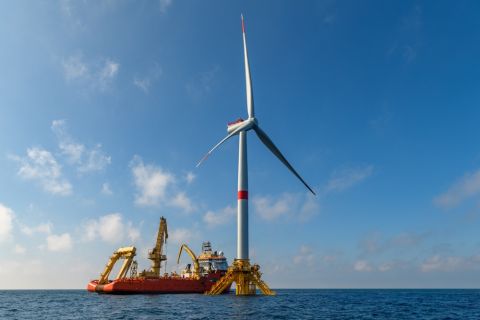One could argue that Matthew Simmons, one of the industry's foremost analysts, is a descendant of Paul Revere. For 20 years, whether speaking at conferences, writing white papers or counseling government officials, he has sounded the alarm-but not that the Redcoats are coming. No, he has warned about something else-declining production and hastening depletion rates; the lack of timely, quality data describing these trends; and the aged rig fleet, pipeline system and other equipment and infrastructure. It's all coming true. In a speech in 1998, Simmons said the supply response following $10 oil in 1997-98 would be "savage." "Oil and gas demand is not yet obsolete. But depletion will drive this business in the next 10 years. It is more powerful than demand." Simmons makes a distinction between gross and net depletion. Gross depletion is no mystery, occurring when a passive company does no further drilling or maintenance and just produces its existing fields to their expiration date. Net depletion is a bigger problem because it shows up when production declines after accounting for additional drilling, new technology applications, discoveries and reserve revisions. "This inexorable depletion is the critical issue of our industry," says Henry Groppe, whose Houston consulting firm, Groppe, Long & Littell, has made study of global supply and demand trends its signature. More anecdotal data are supporting that claim. Last November, Shell Oil Products US announced it will close its 70-year-old refinery in Bakersfield, California, by November 2004. "It has been determined that the reduction in San Joaquin heavy-crude production...makes continued operation no longer economically viable. The decline in crude availability has been the major factor in the timing of this decision...," Shell reports. A five-year study by John S. Herold Inc. and Harrison Lovegrove & Co. took a broad look at oil production for some 200 public and private producers. Their U.S. output declined 2.6%, and gas production fell 3% from 1998 to 2002. Their U.S. oil reserves fell 3% although gas reserves increased a healthy 13.4% after production and revisions. No wonder U.S. Secretary of Energy Spencer Abraham is looking for alternatives. Late last year he convened two major international conferences-one on liquefied natural gas (LNG) that drew energy ministers from more than 20 countries; the other on the coming hydrogen (fuel cell) economy that gathered officials from 15 nations. Holding production flat will be a major accomplishment in the face of the maturity of the oil and gas basins in this country and Canada. But flat won't be good enough if demand continues to inch up 1% or 2% every year, as it has in the past. Crude oil U.S. oil production peaked in 1970 at about 9.6 million barrels per day. Since then, despite 30 years of bold technologies and exploring new plays, production has continued its downward path. It reached a modern low of 5.5 million barrels per day in 2003, according to Groppe's initial estimates. The U.S. Energy Information Administration projected 5.7 million a day. (Both projections include Alaska.) Equally troublesome, average well productivity has declined steadily from 15.7 barrels a day per well in 1980, to 11.2 barrels in 2002, the EIA says. Canadian conventional oil production peaked in 1973, according to Canada's National Energy Board (NEB). Then it began a long, slow decline, just as in the U.S. But at the same time, steady development of the country's vast unconventional oil resources has taken place. The surprising net result is that Maple Leaf oil output has reached a new peak today-2.4 million barrels per day. This total includes light and medium conventional oil, steam-assisted heavy oil and oil-sands mining (bitumen) production. In 2003, heavy-oil production surpassed conventional light-oil output for the first time. Indeed, the changing nature of North America's energy mix will become more evident as time passes. Imperial Oil told analysts recently that by 2012, its conventional oil and gas production will have declined from 125,000 barrels of oil equivalent per day to just 40,000 a day. Its increasing heavy-oil and synthetic-crude output will more than offset this decline. Natural gas Marketed U.S. gas production peaked in 1973 at 22.6 trillion cubic feet (Tcf) annually. Groppe's estimate for 2003 is 19.3 Tcf, down about 3.8% from 2002 data. The National Petroleum Council's gas study released in September 2003 concludes that traditional North American producing areas will provide 75% of long-term U.S. gas needs-but will be unable to meet projected demand growth. Residential gas use grew to 60 million homes in 2001 from 48 million in 1987, the EIA says. Industrial gas consumption, while varying due to economic conditions, grew almost 40% during the same period. Total gas demand grew more than 40% between 1986 and 1997, from 16 Tcf per year to 23 Tcf. It has ranged between 22 and 23 Tcf since then. The ability of U.S. and Canadian wells to keep up is in question, as surplus productive capacity appears to be a thing of the past. Higher oil and gas prices do drive increased drilling, but the results are becoming less fruitful, Groppe notes. Initial production per new well is less, and the decline is faster. "I don't think it is possible to reverse the decline, although we can probably have a temporary reduction in the rate of decline," he says. The NPC study results are similar. "The key finding from this analysis [of 10 years of drilling and production data] was that, on average, initial production rates from new wells have been sustained through the use of advanced technology," the NPC reports. "However, production declines from these initial rates have increased significantly. Recoverable volumes from new wells drilled in mature producing basins have declined over time. Without the benefit of new drilling, indigenous supplies have reached a point at which U.S. production declines by 25% to 30% each year. Some 80% of gas production in 10 years will be from wells yet to be drilled." Many production successes can be found in individual fields and some companies. But overall, Wyoming is the only state in the union where gas production has increased in recent years. Canadian gas production in 2003 was about 15.9 billion cubic feet (Bcf) a day, down from 16.4 Bcf in 2002, despite the record number of wells completed, according to Calgary-based investment-banking firm FirstEnergy Capital Corp. The NEB in December was projecting output of 16.2 Bcf per day. Decline data may be skewed by the sharp decline at Ladyfern, the British Columbia giant gas producer that peaked in 2002 at more than 700 million cubic feet a day, but is now producing about 50 million per day. The number of gas wells completed throughout Canada in 2003 will be north of 14,000, compared with just 11,200 completions in 2001, says Martin King, an analyst with FirstEnergy Capital. The NEB reports, "The average productivity of new gas wells in western Canada has been decreasing over the past six or seven years...It is more challenging with each passing year to offset annual decline." In the face of these decline trends, and absent some spectacular discoveries or game-changing technology, operators will have to drill more wells than ever in any given year, to keep pace with projected demand in both countries.
Recommended Reading
SBM Offshore, Technip Enter Floating Offshore Wind JV
2024-03-14 - EkWiL, the 50/50 joint venture entity between the companies, will deploy Technip’s Semi-submersible INO15 by T.E.N. and SBM’s Tension Leg Platform Float4Wind.
Eversource to Sell Sunrise Wind Stake to Ørsted
2024-04-19 - Eversource Energy said it will provide service to Ørsted and remain contracted to lead the onshore construction of Sunrise following the closing of the transaction.
Equinor, Ørsted Bid for Better Contract in NY Offshore Wind Auction
2024-01-26 - New York State has received bids to supply power from three offshore wind projects in its expedited fourth solicitation that allowed developers to exit old contracts and re-offer projects at higher prices.
US Gives Final Green Light to Sunrise Wind Offshore Project
2024-03-26 - The approval by the Bureau of Ocean Energy Management solidified Ørsted and Eversource’s commitment to the project with both taking final investment decisions.
US Clears 2.6-GW Offshore New England Wind Project
2024-04-04 - Located south of Martha’s Vineyard off of Massachusetts, the project consists of the 791-megawatt New England Wind 1 and the 1.87-GW New England Wind 2.




